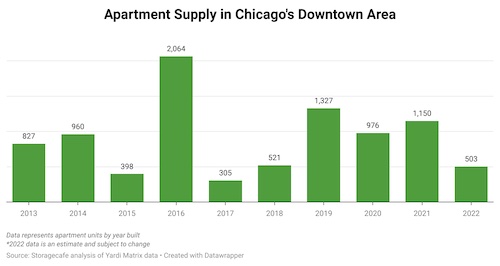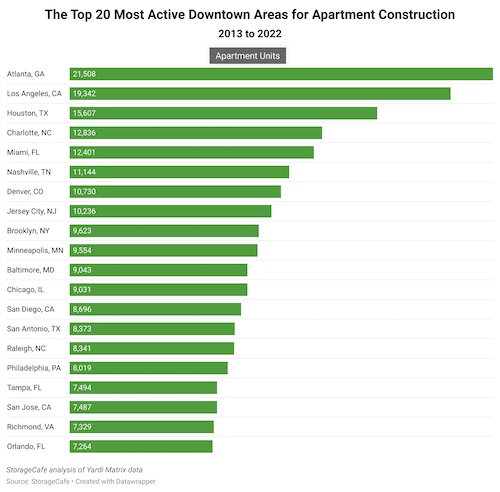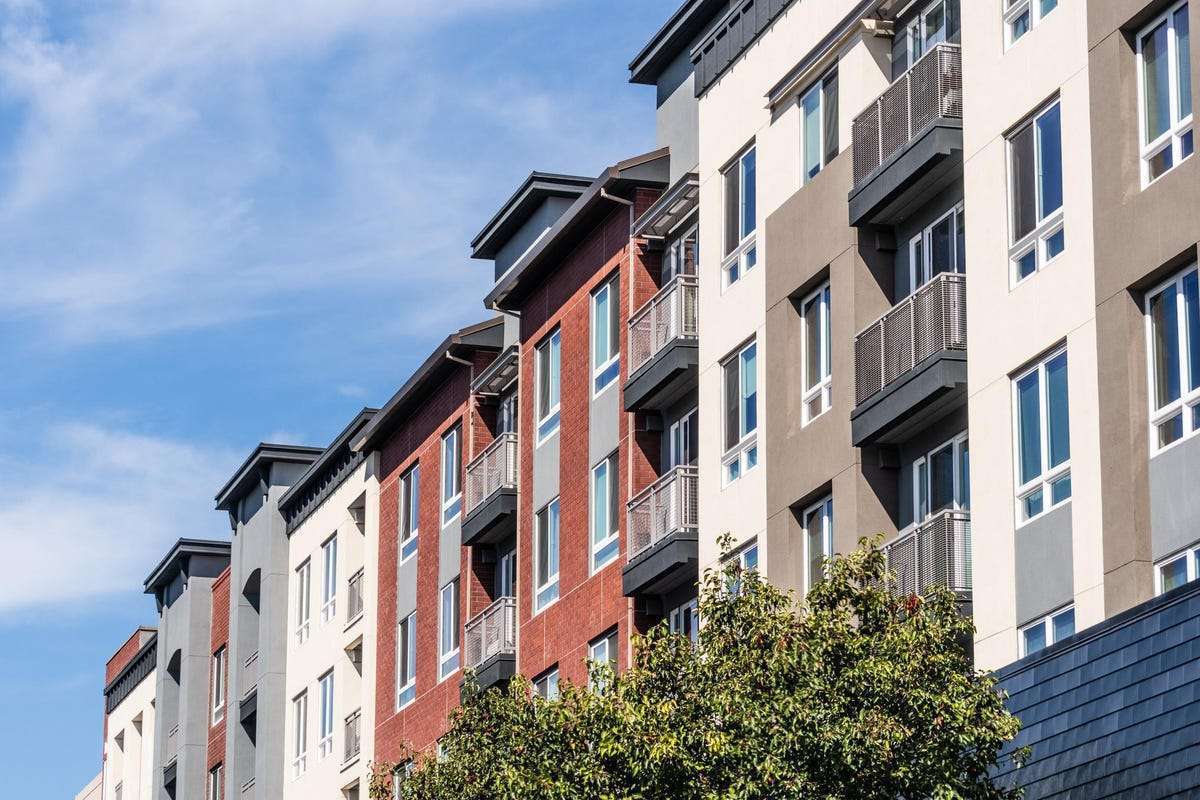eXp Commercial is one of the fastest-growing national commercial real estate brokerage firms. The Chicago Multifamily Brokerage Division focuses on listing and selling multifamily properties throughout the Chicago Area and Suburbs.
Monday, October 17, 2022
Multifamily great place to be
Sunday, October 16, 2022
Legislation Introduced to End Federal CARES Act Notice to Vacate

On September 30, 2022, Rep. Barry Loudermilk (R-GA)introduced the “Respect State Housing Laws Act,” federal legislation that would end the CARES Act notice to vacate requirement. The National Apartment Association (NAA), working alongside the National Association of Residential Property Managers (NARPM), collaborated with Rep. Loudermilk to secure the introduction of this important bill.
In immediate response, NAA and the National Multifamily Housing Council (NMHC) released a statement applauding the introduction of legislation that would help restore normalcy and balance to rental housing operations.
In March 2020, Congress passed the CARES Act, legislation that included a temporary 120-day moratorium on evictions and late fees for federally-backed and federally-assisted housing. The moratorium featured what should have been a temporary notice to vacate requirement. Due to a drafting error in the legislation, however, this provision – which intrudes state and local notice periods – has remained in place long past the moratorium’s expiration, and remains a disputed issue in courts today. Read more on the notice to vacate requirement.
For more than three years, rental housing providers have navigated immense operational hurdles and financial challenges, only exacerbated by federal interference into state and local law. The introduction of this bill is a critical step in the right direction, and NAA will steadfastly advocate to ensure it crosses the finish line.
Source: Legislation Introduced to End Federal CARES Act Notice to Vacate | National Apartment Association
https://www.creconsult.net/market-trends/legislation-introduced-to-end-federal-cares-act-notice-to-vacate-national-apartment-association/Saturday, October 15, 2022
Just Sold! Former UAW Local No 145 Office Building Montgomery IL

Montgomery, IL September 29th, 2022 – eXp Commercial (NASDAQ: EXPI), the fastest growing national commercial real estate brokerage firm, announced today the sale of a 6,758 SF Office Building located in Montgomery, IL.

The property is located at 1700 Oakton Rd in West Suburban Chicago Montgomery, IL and consists of a free-standing 6,758 SF Office Building/Meeting Hall on a 4.7 acre lot. This surplus property intended for the expansion of the adjacent 152 Unit Multifamily Property Victorian Apartments also sold by Randolph Taylor, was formerly owned and operated by the United Auto Workers Local No 145 in Montgomery. The Buyers of the property will be operating the property as a Church.
This was an exclusive listing and the transaction was brokered and both Buyer and Seller were represented by Randolph Taylor a Senior Associate and Multifamily Investment Sales Broker with the Chicago-Naperville eXp Commercial office.
Randolph can be contacted at (630) 474-6441 | rtaylor@creconsult.net
https://www.creconsult.net/company-news/just-sold-former-uaw-local-no-145-office-building-montgomery-il/Friday, October 14, 2022
The most active downtown areas for apartment construction? Chicago is ranked No. 12

Downtown multifamily construction has flourished across the U.S. over the last decade in response to people’s changing preferences. Even with many people’s shift to suburban life caused by COVID-19, the shine of city living has yet to be dimmed.
A majority of the country’s biggest cities have experienced a resurgence of multifamily construction in their central neighborhoods, according to a recent study by StorageCafe. The study looked at the cores of 100 U.S. cities and ranked them based on the number of apartment units delivered since 2013—Downtown Chicago was reported to have had the 12th most impressive transformation.
No less than 9,000 new apartments were added during the decade, increasing the downtown apartment inventory by nearly 50%.

Sure. It’s no secret that office workers aren’t yet returning in droves, but people still seem interested in living there. Downtown has 2,312 new units currently under construction, scheduled to deliver in the next two years, based on the report. Last year was very active in terms of apartment construction, despite pandemic setbacks, as people were eager to return to the hustle and bustle. Over 1,000 new units were delivered in 2021 alone.
But in talking about multifamily construction, one thing must be acknowledged: cost. The cost of renting has risen dramatically, and though that hasn’t at all squashed interest in neighborhoods like Gold Coast, Streeterville or the Loop, it has caused prospective tenants to settle for less when it comes to size. The need for self-storage has skyrocketed because of this, and Downtown Chicago has seen the addition of around 239,000 square feet of self-storage space from 2013 to 2022.
As for the other cities on StorageCafe’s list? Atlanta, Los Angeles and Houston stand in the lead, with the most active markets for new apartment construction. Atlanta alone saw 21,500 new units added to the local inventory during the decade.
Yardi Matrix Business Intelligence Manager Doug Ressler said places like these, which have long attracted workers with in-demand skills, have transformed into hubs where residents can work, live and have easy access to after-work entertainment.
“The massive shifts in housing preferences we’ve witnessed in relation to the health crisis are still bound to have ripple effects for years to come,” Ressler said. “The hybrid or remote working trend, for one, has created a context for a reversed type of migration—it’s not just the employees following available jobs and housing options anymore, but jobs and new construction coming to places where people want to live.”

Source: The most active downtown areas for apartment construction? Chicago is ranked No. 12
https://www.creconsult.net/market-trends/the-most-active-downtown-areas-for-apartment-construction-chicago-is-ranked-no-12/Thursday, October 13, 2022
A CRE Executive's Outlook On Market Optimism
 A variety of unprecedented events over the last few years have impacted markets around the world. There have been growing concerns about inflation across the commercial real estate sector, but the overall economic outlook is positive. However, one element that still worries industry participants is the rise and uncertainty of interest rates. It should be no surprise that inflation has increased as a result of supply chain disruption, manufacturing slowdowns, unanticipated spikes in demand, and the U.S. Federal Reserve pumping money into the economy in an attempt to alleviate these market issues that arose from events like the global pandemic. Overall, rising interest rates have been used as a tool to stifle demand, in the hopes that slowing it down will also slow price escalation.
Manufacturing And Real Estate Amid Economic Uncertainty
At the start of the pandemic, manufacturing and production slowed significantly or shut down as organizations prepared for consumers to cut spending. Surprisingly, demand skyrocketed—but with production scaled back and factories shut down due to Covid-19, it proved difficult to meet the growing need for goods. The pandemic also drove major changes in consumer behavior, including online shopping, remote working, and migration, predominantly to warmer cities and sunbelt markets. All these changes have led to unpredictable shifts in business demand for commercial space, occupancy rates, earnings for commercial real estate and property valuations.
Additionally, the demand for new semiconductor chip plants, battery manufacturing plants, data centers, and electric car manufacturing plants has put incredible pressure on supply resulting in meaningful inflation, material delays, and supply chain disruptions. Capacity restrictions could potentially be stopped or alleviated by central banks. There are long- and short-term ways to impact this, such as reducing quantitative easing, selling bonds, and raising interest rates. This directly affects real estate because when buyers have a higher cost of debt, they are less willing to pay for assets to deliver the same yield or investment returns. In the near term, the rising cost of debt and uncertainty around its availability can make it difficult to underwrite new developments or acquisitions. However, high-barrier-to-entry markets with limited supply or investments with long-term horizons are both still very achievable to finance today.
Rising Rates And Real Estate
The American people’s investment patterns during turbulent times directly impact our economy. Although the market and rates are currently rebounding, public concern makes sense when considering the initial data. The U.S. Labor Department reported that the consumer-price index rose 8.3% for the 12 months ending in August—but this is a smaller figure than the 8.5% increase over the 12-month-period ending in July. Consumers need to note that rates are improving and easing from the unprecedented spikes seen earlier this year.
Insight from Axios and analysts (subscription required) highlights that the public’s general perception and fear could actually seal an economy into a recession. Regardless of the statistical odds of a recession occurring, if the public is wary about opening their wallets, especially in capitalistic markets powered by consumer spending, a recession could become a self-fulfilling prophecy. Public behavior could also cause inflation in a similar way: If individuals and businesses believe the cost of buying goods today will be less expensive than in the future, buying extra goods will inherently drive higher inflation by adding extra demand to an already supply-strained economy.
The Fed has used interest rate hikes to give consumers confidence that inflation will remain in check. But under these circumstances, it has become more difficult to finance new real estate projects or acquire existing assets, leaving buyers unable to predict their cost of debt and developers unable to gauge exit valuation rates when underwriting deals.
This has also brought a steep increase in mortgage rates, causing homeowners to pay higher prices, resulting in an influx of renters and buyers reconsidering deals until prices return to being affordable. It makes sense both that buyers are increasingly rejecting record home prices, while sellers are unwilling to accept a lower price than values achieved only months earlier.
As someone who frequently engages with commercial real estate investors, it’s been interesting to see how many investors have shifted their focus toward build-to-rent and single-family homes. Build-to-rent communities, in particular, offer many of the amenities and luxuries that buyers today seek. I expect that these two areas should do increasingly well in this market as we wait for prices to stabilize.
A Bright Future
Data shows that younger generations have the most positive outlook on their financial futures, with 70% of millennials and 66% of Gen-Z feeling confident versus only 39% of Baby Boomers. The reason for this disparity could be that, historically, the stock market goes up over time, but during this stock dip, those going into retirement are being demoralized by the prospect of seeing their life savings and retirement wiped away.
According to Mortage News Daily’s analyses, current 30-year fixed mortgage rates still show signs of opportunity. People are searching for space to build connections, families, and their dream homes—especially after the pandemic. The valuations of critical real estate assets and stock prices of businesses that are profitable should remain stable and are poised for growth in the future. Predictions are showing the market outlook to be favorable given GDP growth, limited supply of assets, credit availability, and promising forecasts for the real estate industry. This is a time when young investors with ample time and opportunities should capitalize on the market—not run away from it.
A variety of unprecedented events over the last few years have impacted markets around the world. There have been growing concerns about inflation across the commercial real estate sector, but the overall economic outlook is positive. However, one element that still worries industry participants is the rise and uncertainty of interest rates. It should be no surprise that inflation has increased as a result of supply chain disruption, manufacturing slowdowns, unanticipated spikes in demand, and the U.S. Federal Reserve pumping money into the economy in an attempt to alleviate these market issues that arose from events like the global pandemic. Overall, rising interest rates have been used as a tool to stifle demand, in the hopes that slowing it down will also slow price escalation.
Manufacturing And Real Estate Amid Economic Uncertainty
At the start of the pandemic, manufacturing and production slowed significantly or shut down as organizations prepared for consumers to cut spending. Surprisingly, demand skyrocketed—but with production scaled back and factories shut down due to Covid-19, it proved difficult to meet the growing need for goods. The pandemic also drove major changes in consumer behavior, including online shopping, remote working, and migration, predominantly to warmer cities and sunbelt markets. All these changes have led to unpredictable shifts in business demand for commercial space, occupancy rates, earnings for commercial real estate and property valuations.
Additionally, the demand for new semiconductor chip plants, battery manufacturing plants, data centers, and electric car manufacturing plants has put incredible pressure on supply resulting in meaningful inflation, material delays, and supply chain disruptions. Capacity restrictions could potentially be stopped or alleviated by central banks. There are long- and short-term ways to impact this, such as reducing quantitative easing, selling bonds, and raising interest rates. This directly affects real estate because when buyers have a higher cost of debt, they are less willing to pay for assets to deliver the same yield or investment returns. In the near term, the rising cost of debt and uncertainty around its availability can make it difficult to underwrite new developments or acquisitions. However, high-barrier-to-entry markets with limited supply or investments with long-term horizons are both still very achievable to finance today.
Rising Rates And Real Estate
The American people’s investment patterns during turbulent times directly impact our economy. Although the market and rates are currently rebounding, public concern makes sense when considering the initial data. The U.S. Labor Department reported that the consumer-price index rose 8.3% for the 12 months ending in August—but this is a smaller figure than the 8.5% increase over the 12-month-period ending in July. Consumers need to note that rates are improving and easing from the unprecedented spikes seen earlier this year.
Insight from Axios and analysts (subscription required) highlights that the public’s general perception and fear could actually seal an economy into a recession. Regardless of the statistical odds of a recession occurring, if the public is wary about opening their wallets, especially in capitalistic markets powered by consumer spending, a recession could become a self-fulfilling prophecy. Public behavior could also cause inflation in a similar way: If individuals and businesses believe the cost of buying goods today will be less expensive than in the future, buying extra goods will inherently drive higher inflation by adding extra demand to an already supply-strained economy.
The Fed has used interest rate hikes to give consumers confidence that inflation will remain in check. But under these circumstances, it has become more difficult to finance new real estate projects or acquire existing assets, leaving buyers unable to predict their cost of debt and developers unable to gauge exit valuation rates when underwriting deals.
This has also brought a steep increase in mortgage rates, causing homeowners to pay higher prices, resulting in an influx of renters and buyers reconsidering deals until prices return to being affordable. It makes sense both that buyers are increasingly rejecting record home prices, while sellers are unwilling to accept a lower price than values achieved only months earlier.
As someone who frequently engages with commercial real estate investors, it’s been interesting to see how many investors have shifted their focus toward build-to-rent and single-family homes. Build-to-rent communities, in particular, offer many of the amenities and luxuries that buyers today seek. I expect that these two areas should do increasingly well in this market as we wait for prices to stabilize.
A Bright Future
Data shows that younger generations have the most positive outlook on their financial futures, with 70% of millennials and 66% of Gen-Z feeling confident versus only 39% of Baby Boomers. The reason for this disparity could be that, historically, the stock market goes up over time, but during this stock dip, those going into retirement are being demoralized by the prospect of seeing their life savings and retirement wiped away.
According to Mortage News Daily’s analyses, current 30-year fixed mortgage rates still show signs of opportunity. People are searching for space to build connections, families, and their dream homes—especially after the pandemic. The valuations of critical real estate assets and stock prices of businesses that are profitable should remain stable and are poised for growth in the future. Predictions are showing the market outlook to be favorable given GDP growth, limited supply of assets, credit availability, and promising forecasts for the real estate industry. This is a time when young investors with ample time and opportunities should capitalize on the market—not run away from it.
Source: A CRE Executive’s Outlook On Market Optimism
https://www.creconsult.net/market-trends/a-cre-executives-outlook-on-market-optimism/Wednesday, October 12, 2022
Four Reasons Multifamily Will Remain an Attractive Hedge According to One CEO

Necessity, affordability, efficiency, and liquidity are all key drivers for investment in the multifamily space, says AKRU’s Mohsin Masud.
The multifamily asset class will remain a safe place to deploy capital despite rising rates and inflation, one industry watcher tells GlobeSt.com.
Mohsin Masud, the CEO, and founder of AKRU, says multifamily will continue to be a safe place to deploy capital for four key reasons: necessity, affordability, efficiency, and liquidity.
“Everyone needs a place to live. As such, they are likely to prioritize their housing costs in times of economic distress,” Masud says. “We saw this during the height of the pandemic when multifamily occupancy levels stayed relatively stable when compared with office or certain types of retail properties.”
He also notes that the barriers to entry for a multifamily unit are “much lower” than those in the single-family housing market — especially when it comes to cost.
“As the prices for single-family homes continue to outpace wage increases, they become less and less affordable,” he says. “This is particularly true in large metropolitan areas in Florida, Texas, California, and New York (Miami, Dallas and Austin, Los Angeles, and New York City, respectively) that have seen major population increases. In light of this affordability issue, multifamily properties present a more affordable alternative.”
For investors, multifamily also provides scale and efficiency: all of the units are located in one place, making leasing, repairs, and property management easier and more cost-effective. And then there is the liquidity that stems from a “constant state of high demand” from individual and institutional investors alike. Masud also notes that multifamily properties tend to sell for higher prices/lower cap rates, “which helps to turn a profit.”
Masud will elaborate on these insights at GlobeSt’s upcoming Multifamily Conference in Los Angeles in an afternoon session on October 24. He’ll touch on how inflation may impact on the asset class, noting that rent has historically moved in line with inflation since rents and property values are “highly correlated” with rising consumer prices.
“While it is forecasted that inflation will decline markedly as central banks take action to cool global economies, it is important to remember that, historically, higher inflation rates have not systematically affected real estate investment performance,” Masud says, adding that overall fundamentals are strong, and investor interest robust.
“Given the strong fundamentals and wide availability of debt, it is expected that investor interest will remain strong, especially in non-coastal markets and in properties with a strong focus on ESG concerns,” he says. “And tokenizing, or ‘fractionalizing’ CRE, especially multifamily assets creates a whole new level of liquidity for GPs and LPs.
“Up until now, the only way to create liquidity was to sell the asset in its entirety. With the capital markets up in the air, tokenizing an asset allows partial liquidity, while the asset owner still maintains control. This allows them to deploy equity from one asset to a new project, increasing their ability to scale their portfolio.”
Source: Four Reasons Multifamily Will Remain an Attractive Hedge, According to One CEO
https://www.creconsult.net/market-trends/four-reasons-multifamily-will-remain-an-attractive-hedge-according-to-one-ceo/Tuesday, October 11, 2022
Recession in 2023 CRE in Good Shape to Sail Through It

Former US Treasury Secretary sees "substantial ferment and opportunity" for CRE markets in coming contraction.
On a day when a stubbornly high inflation rate threw cold water on everyone’s hope for a soft landing for the US economy, former US Treasury Secretary Lawrence Summers assured CRE executives that “if the car’s going faster, we need a stronger brake, but that doesn’t mean we’ll hit the wall before the car stops.”
In a wide-ranging online discussion hosted by Marcus & Millichap CEO Hessam Nadji on Tuesday, Summers predicted that continued rate increases by the Fed soon will create a “recession of choice” that will bring the unprecedented job growth of the past year to a halt.
“We have incessant inflation due to a collision between demand and supply, and the Fed intends to contain it by restricting demand by raising rates,” Summers said. “My best guess is that the economy will go into recession and we’ll have a year of contraction of job growth.”
But the former Treasury chief said the economy—and the CRE sector in particular—is in much better shape to weather an economic downturn than it was in 2008 when the housing market collapsed.
“We won’t see something like 2008 again,” Summers said, noting that homeowners are much less leveraged, inventory is not overbuilt and lenders are stronger and much more careful in underwriting mortgages than they were during the sub-prime crisis.
Summers signaled that it may take a few months for the recession to materialize because fundamentals like consumer spending remain robust—and still have some room to grow.
“It’s important to remember that there’s still a big savings overhang. The amount of money that people couldn’t spend during the pandemic is $2 trillion,” Summers said.
“Only $300 billion of that has been spent, and more than half of it is [still] in checking accounts. That tells me that consumers will keep going. I don’t think they’ll run out of room to spend because of devalued paychecks,” he said.
Summers counseled CRE players not to assume that “structural” trends that have been unleashed by the pandemic—including the rise of remote work and the surge in e-commerce—will impact negatively on the demand for CRE.
“There will be substantial ferment and opportunity in CRE markets, even in a year—or two—when you won’t see job growth,” Summers said.
“Many people think it will be bad if people work from home. That’s wrong. When people go to different places, their migration becomes a source of real estate demand,” he said, adding that the rapid expansion of e-commerce during the pandemic created an exponential demand for warehouses.
Regarding the office sector, Summers thinks hybrid work is here to stay, but he does not believe it will have as much of an impact on office footprints as some may be projecting.
“A lot of people will go substantially remote. Employers are going to get better at monitoring remote work and they’ll become a bit more accepting of work at home,” he said.
“But if people come to the office three days a week, the employers will want everyone to come in on the same three days, so that will have less impact on office footprints,” Summers said.
In a prediction that is sweet music to the ears of the commercial real estate sector, the former Treasury Secretary said CRE—with cap rates currently averaging 5.7% across asset classes—remains a compelling investment opportunity compared to stocks and bonds.
“The role of CRE in portfolios is likely to be greater” in the months and years to come, Summers said.
“For a large number of portfolios, there should be a larger place for commercial real estate,” Summers said. “It’s substantially tax-advantaged, and on an after-tax basis, it looks even better.”
“A bond is 3.3 percent and that’s all it’s going to be at the end of ten years. The value of the property is vastly more likely to appreciate [over ten years]. It will go up, not down,” he added.
Source: Recession in 2023 CRE in Good Shape to Sail Through It
https://www.creconsult.net/market-trends/recession-in-2023-cre-in-good-shape-to-sail-through-it/🏡 SOUTHEAST DUPAGE MULTIFAMILY: Q4 2025 MARKET SNAPSHOT Quiet stability, high occupancy, and buyers circling for suburban product. In towns...
-
Just Listed: Golf Sumac Medical Offices | Des Plaines IL Price: $3,900,000 SF: 35,245 Stories: 3 Occupancy: 82.3% Cap Rate: 9.63% * Stabiliz...
-
🚨 Office Condo For Sale – Bartlett, IL 📍 802 West Bartlett Road, Bartlett, IL 60103 💰 Listed at $299,900 Unlock the opportunity to own a ...
-
REGISTER TODAY The Commercial Real Estate Symposium will provide junior and senior agents and brokers with valuable insights ...